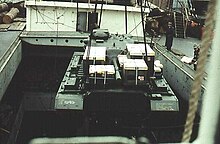hatch


The expression Luke (also Luk ) (Middle Low German, Old Saxon for lukan "to close") denotes an opening in floors, walls or roofs that can usually be closed by a flap ; Luk ( nautical ) denotes an "opening in the deck or in the ship's wall".
etymology
"Luke" comes from the Low German-speaking area, especially from the North Western Pomerania area, and means opening or closure. In houses, it is often the top opening in the roof that was used, for example, to bring in the harvest (floor hatch, roof hatch). The Luke-derived verb "luken" means to look out / look out (to look out of an opening). In the further Low German language area there are various variations of the word. (Source: www.deutsch-plattdeutsch.de).
The word adopted from the Low German seaman's language around 1600 goes back to Middle Low German “ lūke ” (corresponding to Dutch “ luik ”, Danish “ luge ”), which belongs to the Germanic verb “ lūkan ” (to close) discussed under Loch .
Like hole, Luke originally meant “ lock ”.
Hatches in vehicles
Ships
In shipping , hatches are often named according to their purpose, for example companionway hatch (in front of stairs to another deck) or loading hatch (large openings in the deck for loading and unloading ). What they have in common is that they are usually provided with a border, a coaming (hatch coaming) and can be closed watertight with hatch covers . In large ocean-going vessels, the coaming of a loading hatch can easily reach a height of 1.5 meters. The form "Luk" was preferred on submarines of the German Navy. B. Tower hatch.
When the historic sailing ships were built, one or more large hatches were built into the upper deck, which were used to heave cannons, ammunition, provisions and equipment into the ship. For this purpose, cranes from the quay or tackles in the rigging were used. The large hatch could be closed with grating or wooden hatch covers after loading or unloading . Such a large hatch can be seen today on the Vasa .
Planes
In modern aircraft construction, loading hatches can have different shapes and sizes depending on their use. For example, large cargo machines in the military and civilian sector have a hatch in the rear of the machine for the transport of extensive cargo, which takes up almost the entire width of the hull. Passenger planes have in the lower area of the aircraft d. H. Under the passenger deck in the bow and / or stern loading hatches for the luggage of the passengers, air freight and for on-board catering, transport trolleys for the airline catering containers.
Spaceships
Hatches that lead into a ship's hull that is in a vacuum must meet high demands on tightness in every conceivable temperature range . Occasionally they can only be opened here with a destructive effect, using explosive bolts .
Military vehicles
Military vehicles are often equipped with hatches in the driver's cab in order to be able to use weapons, for example machine guns , while driving. These weapons are then attached to specially designed mounts . The gunner can operate the weapon attached to the driver's cab through the hatch.
Other hatches
Skylight
In houses, caravans or mobile homes, there are roof hatches in the form of horizontal or diagonal transparent flaps on the roof . They are used to illuminate and ventilate the interior and, in houses, also as a roof hatch, which is used for maintenance work on the roof or on the chimneys . In contrast to skylights , skylights are more likely to be used in undeveloped roof spaces, for example as a source of daylight for an attic .
Basement hatch
A cellar hatch closes a horizontal or inclined access to a cellar . The basement hatch uses the construction of an upward-opening trap door , which when closed can be part of the floor area . Hatches of this type are often built in to save space or to enable quick filling in cellars used as storage rooms (for example in beer or coal cellars).
Floor hatch
Like the cellar hatch to the basement, the floor hatch closes the access to the attic. Sometimes the floor hatch and floor ladder or attic staircase are connected to one another as a variable staircase .
Luke on ski jumps
On ski jumping and ski flying hills, the athletes used to start from so-called hatches. These were openings that were offset to the left and right of the inrun lane. By choosing a different hatch, the approach could be lengthened or shortened. Since the athletes had to drive into the inrun from the side, it took longer before they could adopt the optimal approach position. Nowadays, ski jumpers start in all official competitions from a bar that is placed across the inrun track, the so-called Happle bar .



